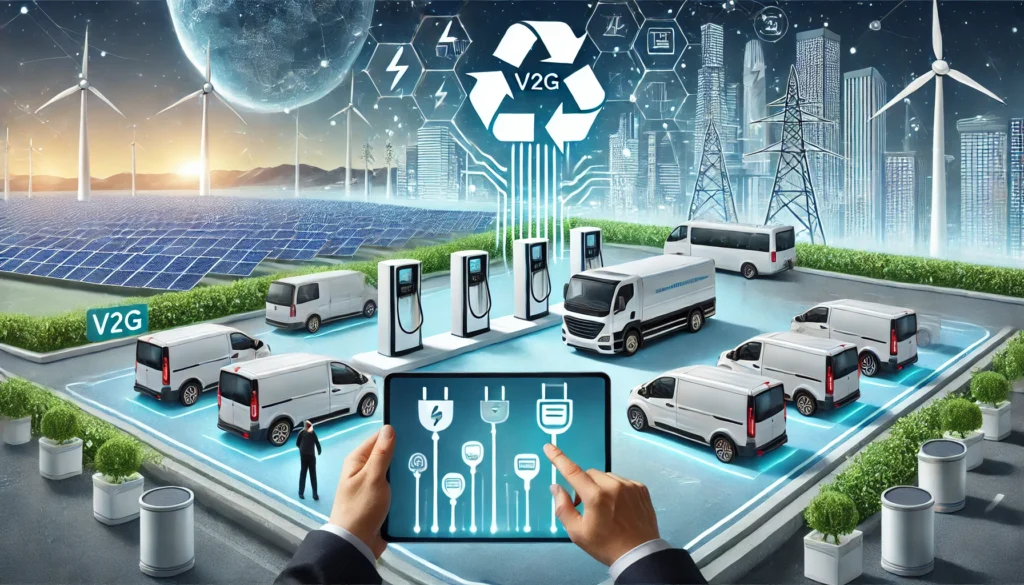As the transition to electric vehicles (EVs) accelerates, fleet managers are seeking innovative ways to reduce costs while optimizing operations. Vehicle-to-Grid (V2G) bidirectional technology is emerging as a game-changer for EV fleets, offering not only cost savings but also enhanced grid resilience, sustainability, and operational flexibility.

Understanding V2G Technology
V2G technology enables bidirectional energy flow between EVs and the power grid. Unlike traditional unidirectional charging, V2G-equipped vehicles can both draw power from the grid and return it. This functionality allows EVs to act as mobile energy storage units, providing services such as:
- Peak Shaving: Returning stored energy to the grid during peak demand periods to reduce strain on the grid and lower energy costs.
- Frequency Regulation: Stabilizing grid frequency by adjusting energy flows in real-time, ensuring smooth operation of the power network.
- Renewable Integration: Storing excess energy generated from renewable sources like solar or wind and feeding it back to the grid when needed, promoting a greener energy mix.
- Emergency Backup: Acting as a reliable power source during outages, ensuring critical operations remain uninterrupted.
By leveraging these capabilities, V2G transforms EVs from simple transportation tools into integral components of a smarter, more sustainable energy ecosystem.
Cost-Saving Benefits of V2G for Fleet Managers
- Revenue Generation Through Grid Services
Fleet managers can monetize V2G-enabled EVs by participating in grid services markets. Utility providers often pay for energy storage and demand response services, creating a new revenue stream. For large fleets, this can translate into substantial earnings over time. - Lower Energy Costs
By strategically charging vehicles during off-peak hours when electricity rates are lower and discharging energy during peak hours, fleets can significantly reduce their overall energy expenses. Dynamic pricing models further enhance these savings by aligning charging schedules with real-time electricity rates. - Reduced Demand Charges
Commercial electricity bills often include demand charges based on the highest power usage during a billing cycle. V2G can help fleets mitigate these charges by using stored energy to meet high demand periods. This approach ensures that operational peaks are smoothed out without incurring additional costs. - Battery Lifecycle Optimization
While there is a concern about additional wear on batteries, smart V2G systems manage charge and discharge cycles to optimize battery health. These systems ensure energy flows remain within safe parameters, extending battery life and reducing replacement costs. In fact, some studies suggest that controlled cycling can even enhance battery performance by preventing prolonged periods of inactivity. - Enhanced Operational Resilience
By enabling energy independence during grid disruptions, V2G provides fleets with an added layer of operational security. This is particularly valuable for fleets that operate in areas prone to outages or with critical delivery schedules.
Implementation Strategies for Fleet Managers
- Adopt V2G-Compatible EVs and Chargers
Not all EVs and charging stations support V2G. Fleet managers need to ensure their vehicles and infrastructure are equipped with bidirectional capabilities. This may require upgrading existing equipment or prioritizing V2G-ready vehicles during fleet expansion. - Partner with Utilities and Aggregators
Collaborating with energy providers or third-party aggregators simplifies the process of integrating V2G technology and accessing grid service markets. Aggregators act as intermediaries, pooling energy resources from multiple EVs and coordinating their interaction with the grid to maximize financial returns. - Leverage Smart Charging Software
Advanced software solutions can optimize charging and discharging schedules, ensuring energy transactions align with cost-saving goals and operational requirements. These platforms often incorporate artificial intelligence to adapt to changing energy prices, grid demands, and fleet usage patterns. - Monitor Policy and Incentive Programs
Governments and utilities often provide incentives for V2G adoption, including subsidies, tax breaks, or participation rewards in energy markets. Staying informed about these opportunities can significantly amplify savings and offset initial setup costs. - Train Staff and Update Protocols
Introducing V2G technology requires a knowledgeable team. Training drivers and fleet managers on how to use the system effectively ensures seamless integration into daily operations and maximizes benefits.
Real-World Applications
Several pilot programs and early adopters demonstrate the potential of V2G technology for fleets:
- Electric School Buses: Fleets in the U.S. have used V2G to generate income during summer months when buses are idle. These programs also provide backup power to schools during emergencies.
- Corporate Fleets: Companies in Europe and Asia are integrating V2G to balance renewable energy usage and lower operational costs. Some corporations have reported significant reductions in demand charges by leveraging V2G during peak hours.
- Municipal Services: Cities are deploying V2G-enabled garbage trucks and public transport vehicles to support grid stabilization and reduce urban energy costs.
The Future of Fleet Management with V2G
As energy grids evolve to accommodate more renewable sources, the demand for flexible energy solutions like V2G will grow. Fleet managers who embrace this technology stand to benefit from reduced costs, improved sustainability metrics, and enhanced operational resilience. Moreover, V2G aligns with corporate social responsibility goals, showcasing a commitment to innovation and environmental stewardship.
By adopting V2G, fleet managers can turn their EVs into not just transportation assets but also valuable energy resources—a win-win for businesses, the grid, and the environment. This transformative approach positions fleets at the forefront of the clean energy revolution, driving both profitability and progress in a rapidly changing world.